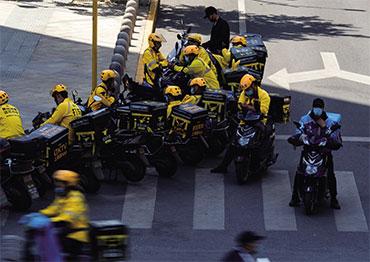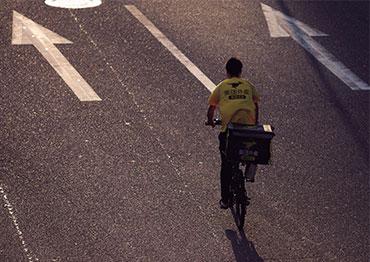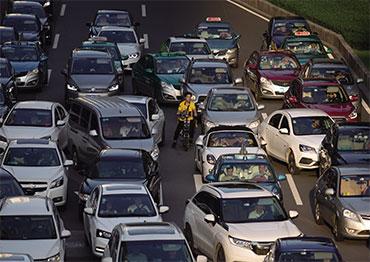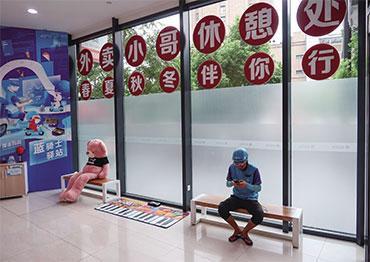The two biggest food delivery platforms in China are Tencentbacked Meituan, and rival Ele.me, owned by tech rival Alibaba Group. Figures released for 2020 show Meituan capturing an even bigger share of the market with 67.3 percent over Ele.me’s 26.9 percent. Star.ele.me, its premium service, has 4.0 percent, with others making up only 1.8 percent, according to data from Statista in April.
As the internet service industry grows, it has attracted more workers of all ages. According to the most recent government statistics, in 2019, the number of employees in the Chinese express delivery industry exceeded 10 million, with at least 7 million more in the food delivery sector.
Meituan had more than 4 million delivery riders registered on its platform in 2020, and Ele.me had more than 3 million.
One Meituan delivery rider, 29-year-old Xiao Yue, said this increased number of riders means longer working hours, not shorter, as more riders compete for delivery slots. Delivery riders from Meituan and Ele.me told NewsChina that most riders work a minimum of 12 hours a day, and many work up to 18 or 19 hours.
On June 2, from 6am to 11am, Xiao Yue delivered 12 orders, making 84 yuan (US$13), an average of 7 yuan per delivery. At lunch time when business is good, riders try to get as many orders as they can. “I can make a maximum 30 to 40 orders a day from 6am to 11pm, and this means I get a monthly salary of around 10,000 yuan (US$1,562),” Xiao Yue said, adding that he sleeps at most four or five hours a day. He lives in a village in the rural-urban fringe zone of northeastern Beijing, and his rent increased from around 800 yuan a month (US$125) to 1,200 yuan (US$187) this year.
As the platform hired more riders to make it more efficient, Xiao Yue said the team in his patch of roughly 20 square kilometers expanded from 40 to 70 riders in the last three months. “This means I struggle to get enough orders during the same working hours, so I have to work extra every day to make up the difference.”
As it expanded the number of riders, profits increased. In 2020, Meituan recorded 66 billion yuan (US$10.3b) in food delivery. The company has other businesses too, including ride sharing and travel. The food ordering industry in China reached an estimated 665 billion yuan (US$97b) in 2020, Techcrunch reported, with 395 million, or 45 percent of the country’s internet users having ordered food delivery online.
The attraction of better pay and greater flexibility of the delivery industry lured more people in, particularly factory workers and other manual laborers. There was also an influx of labor in 2020 due to the pandemic, when many people were laid off as factories and businesses were shut. Riders value the idea of freelancing, although in practice they may end up working longer. Still, it frees them from strict shift times in factories and other jobs, and they can take time off if they need to.
“I think this job is more flexible. I quit my former job at Beijing Capital International Airport to become a delivery rider earlier this year. I work from 6am to 9pm every day, and I make 6,000-7,000 yuan (US$937-1,093) a month,” a rider surname Wang, 43, told the reporter in early June.
Yet the freedom is a trade-off between a long working day, absence of social insurance from the employer, and other challenging factors. Delivery riders do not sign a formal labor contract, instead they register with an intermediate body so employers like Meituan do not need to pay social insurance contributions for riders. “We only have employment injury insurance partially paid by the employer,” said a Meituan delivery rider surnamed Li.
When a customer places an order on a delivery app, they can track the rider’s progress on a map. Seen as an innovation for customers, in reality the riders describe the delivery process as “dangerous,” “adventurous” and even “life threatening.”
Each order has to be delivered within a specified time offered by the platform calculated by the algorithm, which does not take real-world conditions into consideration like weather, traffic, red lights, viaducts, one-way streets, speed limits and elevator time. To make their delivery targets, riders resort to speeding, riding on the wrong side of the road and running red lights. If the customer files a negative complaint or review, their income may be docked anyway. Working long hours on little sleep increase the danger for all road users, including pedestrians, other drivers and the delivery riders themselves.
According to an exposé by People magazine titled “Takeaway Delivery Riders: Trapped in a System” in September 2020, in 2019, the average time for each order was shortened by at least 10 minutes compared with three years earlier. Data from traffic departments in different places indicates the high risk food delivery riders face and the dangers they pose to other road users. According to Shanghai Municipal Public Security Bureau, in the first half of 2019, on average, one takeout rider died because of a traffic accident every 2.5 days. Shanghai police recorded 325 injuries and deaths of takeout and parcel delivery riders in the same period, with Meituan and Ele.me riders accounting for 70 percent. In the same year, Shenzhen, South China’s Guangdong Province, saw 12 deadly traffic incidents among delivery riders within three months. In 2018, Chengdu traffic police levied 10,000 fines on delivery riders who violated traffic rules within a seven-month period.
The report highlighted that riders are often directed along dangerous roads, sidewalks, one-way and pedestrianized streets. The article was viewed millions of times, with many people commenting that they would not mind waiting a bit longer for their food. Ele.me responded by adding a button to allow customers to choose to wait longer, and Meituan said it would allow more flexibility, while critics said the firms were both passing the buck to customers and doing nothing to address the real issues.
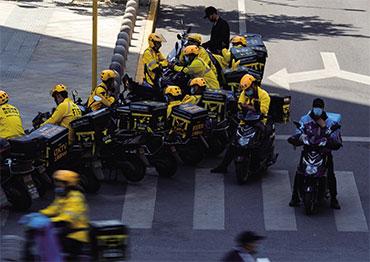
 Old Version
Old Version
